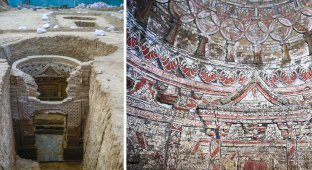Intact priestly burials with a large number of funeral utensils were excavated in Egypt (9 photos)
Mummies in painted sarcophagi, thousands of ushabtis and a 15-meter-high papyrus were found. 
Untouched burials from the New Kingdom and Late Period were discovered by archaeologists in the El-Gureifa area, on the territory of the Tuna el-Gebel necropolis in Middle Egypt. Among the finds are painted anthropomorphic sarcophagi with preserved mummies, thousands of ushabti figurines, amulets and other burial goods, as well as a papyrus about 15 meters long with the text “Book of the Dead”. The Egyptian Ministry of Tourism and Antiquities talks about the findings in a press release, as well as Ahram Online. 
The necropolis in the archaeological zone of Tuna el-Gebel (El-Ghureyfa district in Minya province) belonged to the ancient city of Hemen, which the Greeks called Hermopolis, the center of the cult of the god of wisdom, writing and magic, Thoth. Many of the burials found here date back to Greco-Roman times, including the well-known tomb of the priest Petosiris or a family tomb with 50 mummies excavated in 2019. Other monuments date from the Late Period (7th–4th centuries BC), such as the priestly tombs of the 26th dynasty or the numerous mummies of ibises and baboons, Thoth’s sacred animals. 

Employees of the Egyptian archaeological mission in the El-Ghureif area managed to make finds, some of which belong to the earlier era of the New Kingdom (second half of the 2nd millennium BC). The Secretary General of the Supreme Council of Antiquities, Mostafa Waziri, spoke about them. Scientists have discovered graves carved into the rock, many of which remain intact and contain mummies and funerary utensils. Researchers counted about 25 thousand Ushabti figurines alone. 

Tombs dating back to the New Kingdom have been found for the first time in El Ghureyfa. The richest of them in terms of the amount of inventory belonged to the priest of the god Amon named Thutmes and the priestess Nani, who during her lifetime served as the singer of the god Thoth. 
The priests were accompanied to the afterlife by hundreds of ushabti made of ceramics and Egyptian faience, jewelry, amulets, wooden and stone figurines of Anubis. The mummies were kept in anthropomorphic painted sarcophagi and were covered with carved overlays and polychrome painting. 
The burials of the Late Period turned out to be no less rich in burial utensils. Thus, in the grave of the woman Tadi-Iset, the daughter of the priest Thoth named Irethor, archaeologists found figurines of the syncretic deity Ptah-Sokar-Osiris, two wooden boxes with canopic jars - vessels for entrails - and many ushabti. The mummy of a noble lady also rested in a painted sarcophagus, and for her posthumous journey she was provided with the “Book of the Dead.” The length of the well-preserved scroll, which has yet to undergo conservation procedures, is estimated by scientists at 13–15 meters. 
Such a find, according to Waziri, was also made in the Al-Ghureif area for the first time.






























